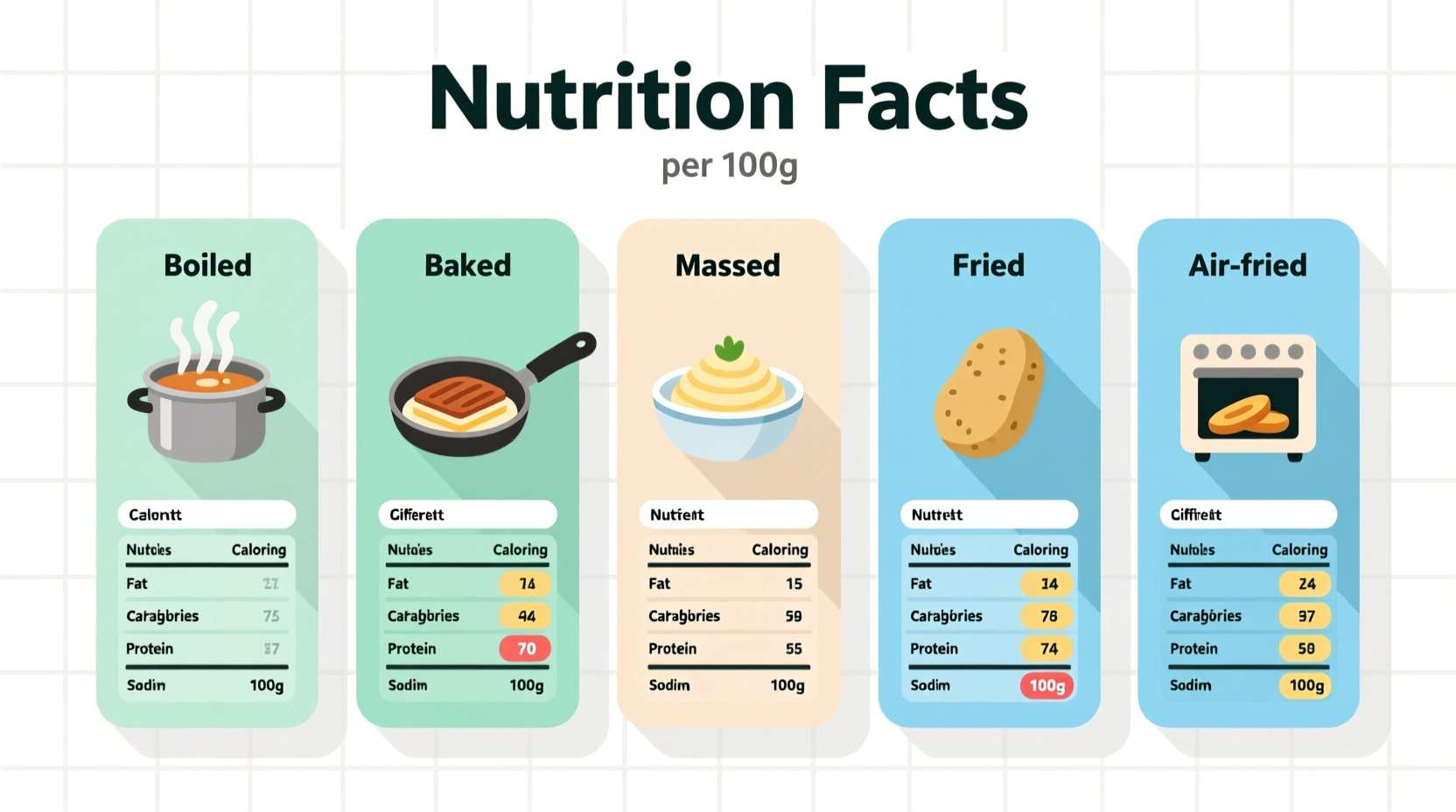A medium-sized potato (5.3 ounces or 148 grams) with skin contains approximately 110 calories. This foundational nutritional fact applies to a plain, baked russet potato—the most commonly consumed variety in the United States. Calorie counts vary based on potato type, size, and preparation method, ranging from 77 calories per 100g for raw potatoes to over 300 calories for fried preparations.
Understanding potato calories matters whether you're tracking macros, managing weight, or simply making informed food choices. Potatoes often get unfairly labeled as "high-carb" foods, but their actual nutritional profile tells a more nuanced story. Let's explore exactly how many calories you're getting from this versatile vegetable and what factors influence those numbers.
Breaking Down Potato Calories by Type
Not all potatoes are nutritionally identical. The variety you choose impacts both calorie density and nutritional composition. Here's how common potato types compare based on USDA FoodData Central measurements:
| Potato Type | Size | Calories | Carbohydrates | Fiber |
|---|---|---|---|---|
| Russet (baked) | 5.3 oz (148g) | 110 | 26g | 2.1g |
| Red potato (boiled) | 5.3 oz (148g) | 100 | 23g | 2.0g |
| Sweet potato (baked) | 5.3 oz (148g) | 112 | 26g | 3.8g |
| Yukon Gold (boiled) | 5.3 oz (148g) | 105 | 24g | 2.0g |
| Potato (raw) | 100g | 77 | 17g | 2.1g |
This nutritional comparison shows that while potato varieties differ slightly in calorie content, the differences are minimal when comparing equal weights. The USDA National Nutrient Database remains the gold standard for this information, providing laboratory-verified measurements that nutrition professionals rely on.
How Preparation Changes Calorie Content
What you do with your potato dramatically impacts its calorie profile. The same potato can range from a low-calorie side dish to a calorie-dense indulgence depending on preparation:
- Baking or boiling (no additions): Preserves the potato's natural calorie count (approximately 110 calories for medium potato)
- Mashed with milk and butter: Adds 50-100+ calories depending on dairy quantities
- French fries (commercial): Soaks up oil during frying, increasing to 365 calories for a medium serving
- Roasted with oil: Adds 45-90 calories per teaspoon of oil used
- Air-fried: Uses minimal oil, keeping calories closer to baked potato levels
According to research published in the Journal of Food Composition and Analysis, frying increases potato calorie density by 60-70% compared to boiling, while baking maintains calorie levels closest to the raw vegetable. This preparation factor matters more than the potato variety itself when tracking calories.

Why Potato Calories Come With Nutritional Benefits
Unlike many calorie sources, potatoes deliver substantial nutritional value beyond their energy content. A medium potato provides:
- 37% of your daily vitamin C needs
- 31% of vitamin B6 requirements
- 27% of potassium intake
- Significant magnesium and iron
- Naturally fat-free composition
The Academy of Nutrition and Dietetics emphasizes that potatoes' nutrient density makes them valuable in balanced diets. Their natural potassium content actually exceeds that of bananas, supporting healthy blood pressure regulation. When prepared without added fats, potatoes offer sustained energy from complex carbohydrates with a moderate glycemic index.
Practical Guidance for Different Dietary Approaches
Whether you're following a specific eating plan or simply tracking calories, these evidence-based strategies help you incorporate potatoes wisely:
For Weight Management
Keep portions to one medium potato (5.3 oz) and choose baking or boiling over frying. The fiber content promotes satiety—studies show boiled potatoes rank highest on the satiety index of common foods, helping you feel full longer than many other carbohydrate sources.
For Low-Carb Diets
Limited potato consumption may fit within moderate low-carb plans. A small red potato (2.5 oz) contains about 45 calories and 10g carbs—comparable to half a banana. Pair with protein and non-starchy vegetables to balance the meal.
For Athletes and Active Individuals
Potatoes provide ideal carbohydrate timing before and after workouts. Research from the American College of Sports Medicine shows that the combination of carbohydrates and potassium in potatoes supports both energy needs and electrolyte balance during physical activity.
Common Misconceptions About Potato Calories
Several myths persist about potatoes and calories that deserve clarification:
- "Potatoes are high in empty calories" - False. Potatoes contain significant vitamins, minerals, and fiber per calorie
- "Sweet potatoes are always lower calorie than white potatoes" - Not true. Calorie counts are nearly identical when comparing equal weights
- "Eating potatoes at night causes weight gain" - No scientific evidence supports this claim; total daily calories matter more than timing
The Harvard T.H. Chan School of Public Health confirms that potatoes themselves aren't problematic—it's the preparation methods and portion sizes that determine their impact on weight management. Their natural composition makes them a valuable part of diverse dietary patterns when consumed appropriately.
Putting Potato Calories in Context
When evaluating potato calories, consider them within your overall dietary pattern rather than in isolation. A medium potato contains fewer calories than:
- A single bagel (280-350 calories)
- A standard serving of pasta (200-220 calories)
- Many commercial granola bars (200+ calories)
What makes potatoes nutritionally distinctive is their combination of energy, fiber, and micronutrients. Unlike refined carbohydrates, they provide sustained energy release when prepared properly. The key is maintaining awareness of preparation methods and portion sizes to align with your nutritional goals.











 浙公网安备
33010002000092号
浙公网安备
33010002000092号 浙B2-20120091-4
浙B2-20120091-4